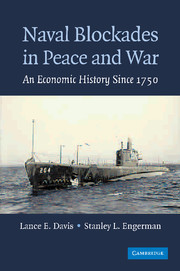Description
Naval Blockades in Peace and War
An Economic History since 1750
Authors: Davis Lance E., Engerman Stanley L.
An examination of the effectiveness of naval blockades and sanctions since 1750.
Language: English
Subject for Naval Blockades in Peace and War:
Approximative price 63.71 €
In Print (Delivery period: 14 days).
Add to cart
Naval Blockades in Peace and War
Publication date: 08-2012
Support: Print on demand
Publication date: 08-2012
Support: Print on demand
Approximative price 129.87 €
Subject to availability at the publisher.
Add to cart
Naval blockades in peace and war: an economic history since 1750
Publication date: 12-2006
464 p. · 15.2x22.9 cm · Hardback
Publication date: 12-2006
464 p. · 15.2x22.9 cm · Hardback
Description
/li>Contents
/li>
A number of major blockades, including the Continental System in the Napoleonic Wars, the War of 1812, the American Civil War, and World Wars I and II, in addition to the increased use of peacetime blockades and sanctions with the hope of avoiding war, are examined in this book. The impact of technology and organizational changes on the nature of blockades and their effectiveness as military measures are discussed. Legal, economic, and political questions are explored to understand the various constraints upon belligerent behavior. The analysis draw upon the extensive amount of quantitative material available from military publications.
Preface; 1. Introduction: 'Thou shalt not pass'; 2. Britain, France and Napoleon's Continental Systems, 1793–1815; 3. The United States versus Great Britain, 1776–1815; 4. The North blockades the Confederacy, 1861–5; 5. International law and naval blockades during World War I: Britain, Germany, and the United States: traditional strategies versus the submarine; 6. Legal and economic aspects of naval blockades: the United States, Great Britain, and Germany in World War II; 7. The American submarine and aerial mine blockade of the Japanese home islands, 1941–5; 8. Blockades without war: from Pacific blockades to sanctions; 9. Blockades, war and international law: what it all means; Conclusion.
© 2024 LAVOISIER S.A.S.




